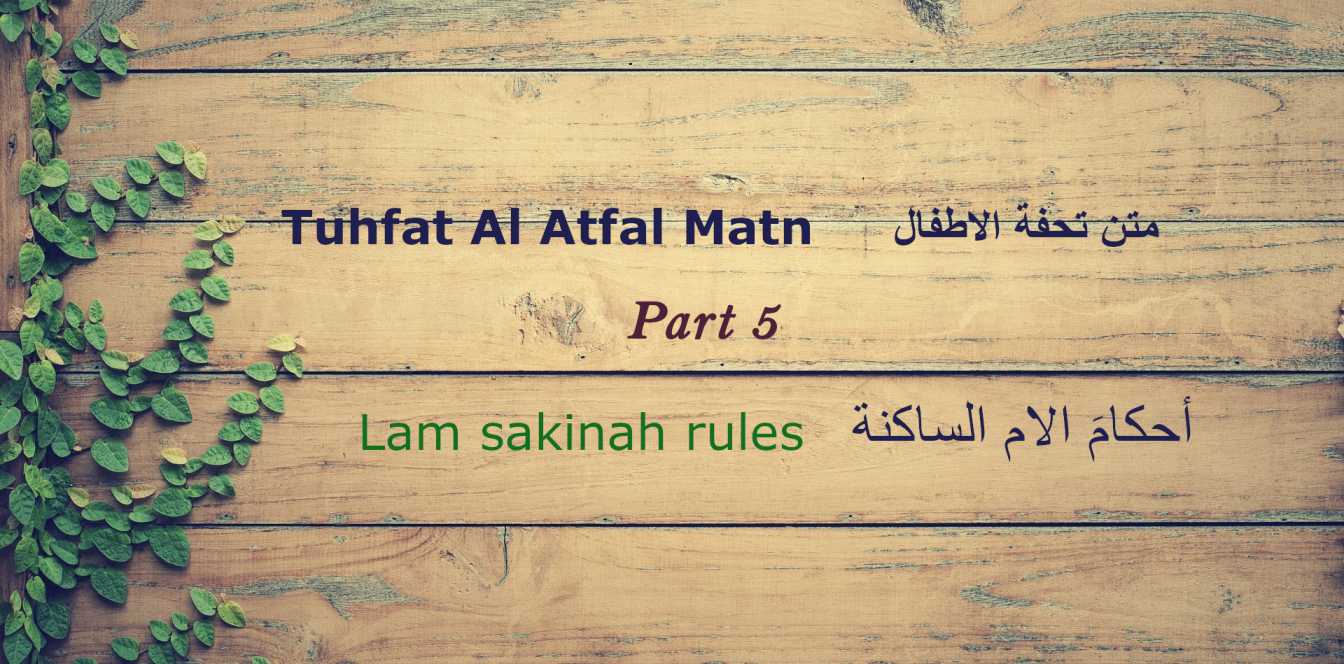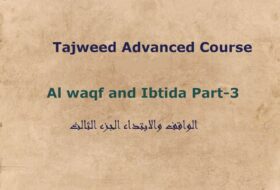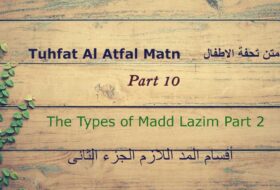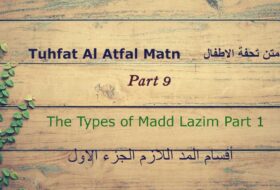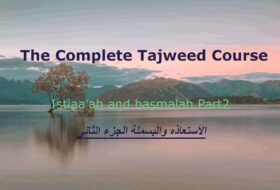The Ruling of Lam of (ال) and Lam of the Verb حكم لام أل و لام الفعل
See Part 1 Part 2 Part3 part4 part6
حكم لام أل و لام الفعل
لِلامِ أَلْ حَــالانِ قَبْـلَ الأَحْـــرُفِ أُولاهُمَــا إِظْهَـــارُهَا فَلتَعْرِفِ
قَبْـلَ ارْبَـعٍ مَـعْ عَشْرَةٍ خُذْ عِلْمَـهُ مِنِ ابْـغِ حَجَّكَ وَخَــفْ عَقِيمَهُ
ثَانِيهَمَــا إدْغَامُهَـا فـِي أَرْبَــعِ وَعَشْرَةٍ أَيْضــاً وَرَمْزَهَا فَــعِِ
طِبْ ثُمَّ صِلْ رَحْماً تَفُزْ ضِفْ ذَا نِعَـمْ دَعْ سُوءَ ظَنًّ زُرْ شرِيفــاً لِلكَرمْ
وَاللامُ الأُولَــي سَمَّـهَا قَمْـــرِيَّهْ وَاللامَ الأٌخْرَي سَمَّــهَا شَمْسِيَّهْ
وَأَظْهِــرَنَّ لامَ فِعْــلٍ مُطْلَقَـــاً فِي نَحْوِ قُلْ نَعَمْ وَقُلنَا وَالْتَقــي
Introduction:
In this chapter the author discusses two types of lams; lam altaʿrīf (definite article) and the lām which appears in a verb. The lam al-taʿrif is used to make an indefinite word definite e.g. ٌقلم a and) pen القلم or), pen the (نور ) a light) and ُالنور ) the light).
The قلم and نور words are indefinite since they refer to any pen or any light. By adding the laam al-taʿrīf ( ال ) the words become definite in that they now refer to a particular pen or light.
The second lam the author discusses is the lam sakinah which appears in a verb, whether the verb is past tense (maḍi) e.g. ( أنزلنا ) present/future tense (muḍariʿ) e.g. ( يلعب ) or an imperative command amr ( ( والق عصاك The author discusses these lams particularly in regard to whether iṭḥ-har be made in them or idgham.
TEXT: 24
لِلامِ أَلْ حَــالانِ قَبْـلَ الأَحْـــرُفِ أُولاهُمَــا إِظْهَـــارُهَا فَلتَعْرِفِ
VOCABULARY:
حَــالانِ – two conditions
أُولاهُمَــا – the first of the two
إِظْهَـــارُهَا – the iṭḥ-hār of it (the lām)
فَلتَعْرِفِ – so know (this rule of iṭḥ-har of the lam). Most copies mention it like this.
TRANSLATION:
24. For the laam of al there are two conditions before the letters (of the alphabet). The first of the two is the iṭḥ-har of it (the laam), so know this.
COMMENTARY:
The author begins by explaining laam al-taʿrīf, stating that it cannot be void of one of two conditions when appearing before the letters of the alphabet. The first of the two conditions is iṭḥ-har, where the lam should be read clearly.
In the following line the author mentions all the letters of the alphabet which, if preceded by a lam al-taʿrīf, require iṭḥ-har to be made.
TEXT: 25
قَبْـلَ ارْبَـعٍ مَـعْ عَشْرَةٍ خُذْ عِلْمَـهُ مِنِ ابْـغِ حَجَّكَ وَخَــفْ عَقِيمَهُ
VOCABULARY:
ارْبَـعٍ مَـعْ عَشْرَةٍ – four with ten i.e. fourteen
عِلْمَـهُ – its knowledge (of the fourteen letters, where iṭḥ-har will be made)
ابْـغِ – desire, wishful
حَجَّكَ – hajj your (pilgrimage )
وَخَــفْ – fear
عَقِيمَهُ -َ it will be fruitless, unproductive, barren.
TRANSLATION:
25. Before four with ten (fourteen letters). Take its knowledge from (the words): ابْـغِ حَجَّكَ وَخَــفْ عَقِيمَهُ Be desirous of your pilgrimage and fear that it be barren).
COMMENTARY:
In this line the author mentions fourteen letters by which iṭḥ-har of the lam al-taʿrif will be made. If any of these letters appear after the lam al-taʿrif, then it will be read clearly (iṭḥ-har). To remember these letters the student needs simply to memorise the combination of words:
TEXT: 26
ثَانِيهَمَــا إدْغَامُهَـا فـِي أَرْبَــعِ وَعَشْرَةٍ أَيْضــاً وَرَمْزَهَا فَــعِِ
VOCABULARY:
ثَانِيهَمَــا – the second of the two (conditions)
إدْغَامُهَـا – idgham of it (the laam al-taʿrif)
فـِي أَرْبَــعِ وَعَشْرَةٍ – four and ten i.e. fourteen
أَيْضــاً – alsoَ
وَرَمْزَهَا – its combination/code
فَــعِِ – comes يعى – وعى which means to memorise/remember – وَرَمْزَهَا فَــعِِ
TRANSLATION:
26. The second of the two (conditions) is the idgham of it (the lam al-taʿrif) in four and ten (fourteen letters) also, so memorise its combination:
COMMENTARY:
After explaining the first condition, the author begins expounding upon the second condition, which is idgham. Like iṭḥ-haar, idgham will also take place if the laam al-taʿrif is followed by fourteen letters. The combination to remember these fourteen letters are in the initial letters of the words in the following line (similar to the letters of ikhfa):
TEXT: 27
طِبْ ثُمَّ صِلْ رَحْماً تَفُزْ ضِفْ ذَا نِعَـمْ دَعْ سُوءَ ظَنًّ زُرْ شرِيفــاً لِلكَرمْ
VOCABULARY:
طِبْ – beِ good
صِلْ – ِjoin ties (family relations)
رَحْماً – family, relations
تَفُزْ – success
ضِفْ – ِbe hospitable, good host
ذَا نِعَـمْ – َpossessor of favors/bounties
دَعْ – leave , shun
سُوءَ – evil, badُ
ظَنًّ – thought
زُرْ – visitُ
شرِيفــاً – distinguished, illustrious
لِلكَرمْ – for honour, generosity
TRANSLATION:
27. Be good, then join (family) ties and you will be successful. Be hospitable to the possessor of bounties. Shun evil thought. Visit the distinguished for generosity.
COMMENTARY:
This line gathers all fourteen letters into which idgham of the lam al-taʿrif will be made. If the student learns it, he will easily retain them, knowing that if any of these letters follow the lشm al-taʿreef, then idgham will be made; the lam will be assimilated into the letter following it.
Even though the line contains sound advice, the object is not the meaning, rather it provides a means of learning all the fourteen letters of idgham.
The student should note that the alif is not mentioned in any of the two combinations. This is because the alif will never follow the lam al-taʿrif since both the alif and the laam are saakin .
TEXT: 28
وَاللامُ الأُولَــي سَمَّـهَا قَمْـــرِيَّهْ وَاللامَ الأٌخْرَي سَمَّــهَا شَمْسِيَّهْ
VOCABULARY:
الأُولَــي – the first
قَمْـــرِيَّهْ – lunar (referring to the moon)
الأٌخْرَي – second the
شَمْسِيَّهْ – solar ( referring to the sun)
TRANSLATION:
28. And the first lam, name it qamariyyah (lam al-qamariyyah – the lunar lam), and the second lam, name it shamsiyyah (lam alshamsiyyah – the solar laam).
COMMENTARY:
The first laam, which is read with iṭḥ-har, is called laam alqamariyyah because in the word القمر the laam is read with iṭḥ-haar.
The second laam, which is read with idgham, is called lām alshamsiyyah because in الشمس the laam is read with idghaam.
Most copies mention the Meems of واللام with a fatḥah. Muḥammad Atiq Deobandi has both Meems with a ḍammah.
TEXT: 29
وَأَظْهِــرَنَّ لامَ فِعْــلٍ مُطْلَقَـــاً فِي نَحْوِ قُلْ نَعَمْ وَقُلنَا وَالْتَقــي
VOCABULARY:
وَأَظْهِــرَنَّ – be sure to make clear, most certainly make clear
لامَ فِعْــلٍ – the lam of the verb
مُطْلَقَـــاً – generally
فِي نَحْوِ – ِin for example
TRANSLATION:
29. Be sure to make clear the lām of the verb in general, in for example: قل نعم and قلنا and التقى
COMMENTARY:
After explaining the rules regarding laam al-taʿreef, the author starts mentioning the rules of the laam of the verb; stating that in general it is read with iṭḥ-har.
The reason for explicitly mentioning this rule is because some might compare the laam of the verb to the laam al-taʿreef; in that when it is followed by a noon, idgham is made e.g. والنجم Therefore, if the laam of the verb is followed by a noon, idgham should also be made. The same will apply to the example of التقى where the laam is read with iṭḥ-har, but when the lam al-taʿrif is followed by a taaʾ, idgham takes place e.g والتين .Due to this, the author specifically mentions
this rule concerning the lam of the verb for the beginner so that he doesn’t make this comparison, resulting in making idgham where it
is not allowed.
laam-saakinah-in-verbs-nouns-command-and-participles
Tuhfat Al-atfal matn part-3 متن تحفة الاطفال
lam-sakinah-rules-definite-article
lam-sakinah-rules

